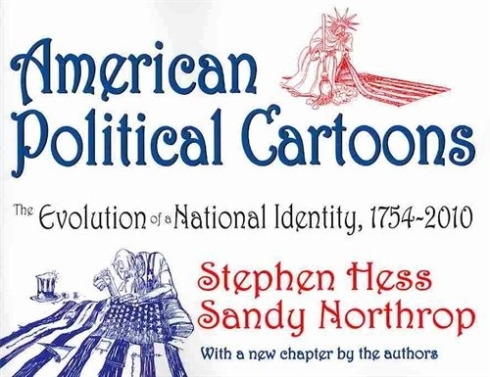
AMERICAN POLITICAL CARTOONS
The latest manifestation of Stephen Hess’s long love affair with editorial cartooning is entitled American Political Cartoons: the Evolution of a National Identity, 1754-2010 (204 7x9-inch landscape pages, b/w; Transaction paperback, $24.95). The book reprints exactly, page for page, an earlier, 1996 tome, Drawn and Quartered: The History of American Political Cartoons, which, like the present volume, is co-authored by Sandy Northrop. To this new edition, the authors have added a 39-page chapter, covering the years since the previous publication, 1997-2010.
The book may be envisioned as an essay on political cartooning, the profession and its craft, bracketing a history of political cartooning in America. The first chapter, repeating the previous edition verbatim, talks generally about the social and political role of the editorial cartoon; the “conclusion” to this essay comes at the end of the book, on the last couple pages:
American Political Cartoons cover “The political cartoon is the embodiment of the American form of government. Democracy is fed by encouraging a free forum for discussion. Wrote historian Larry Mintz: ‘It takes a confident and aggressive society to consider its most serious problems and reduce them to jokes. It involves a willingness to consider the stupidities and errors of one’s environment as less threatening—as, in fact, survivable.’”
This passage makes explicit the connection between editorial cartooning and the “national identity” of the title; the evolution is implicit in the pages of cartoons, 345 of them, ranging across U.S. history from the time of the Founding Fathers through the election of Barack Obama.
Hess has been surveying this landscape for a long time. Writing in the History News Network (hnn.us), Hess confesses that he fell in love with editorial cartoons in 1959 “by accident.” He went to the Library of Congress to find “filler” for a book about presidential candidates that he was writing with his mentor from Johns Hopkins, Malcolm Moos. At the LOC, Hess met curator Milton Kaplan, who opened his eyes to the vast resources of the prints and photographs collections.
With eyes wide open, Hess saw: “Ben Franklin was the first American cartoonist! Paul Revere drew cartoons when colonists couldn’t afford to buy his silverware! Currier & Ives cartooned contentedly for competing sides in any dispute, including slavery! There were the cartoonists in combat with the bosses. Thomas Nast vs. William Tweed. Homer Davenport vs. Mark Hanna. Plus the presidents who must have been created especially for cartoonist’s pen: Abe Lincoln and Teddy Roosevelt.”
Kaplan convinced Hess “that the world needed a history of American political cartoons. After about twenty rejections, Macmillan decided to take a chance. The Ungentlemanly Art was published in 1968, complete with illustrated endnotes” — the most valuable part of the book.
The new last chapter of the present 2010 version of the 1996 book starts by plunging right away into the profession’s present-day plight — alarming attrition in the ranks of full-time staff editorial cartoonists. Only about 75 full-time positions remain, Hess says. In the 1968 Ungentlemanly Art volume, he put the number at about 100; in the 1975 version, he’d upped it to 130. Hess does not dwell long on this dire dilemma; he goes on to muster cartoons on the major events since 1996: Clinton’s impeachment, Bush’s election, 9/11, the invasion of Iraq, 2004 election, and the emergence of animated editorial cartoons on the Internet
More about all, including anecdotes from Hess recalling his adventures with Paul Conrad and Pat Oliphant in assembling the content for the 1968 manifestation, this can be found in the Usual Place, Opus 274.
No comments:
Post a Comment